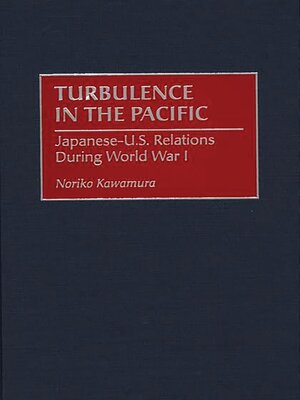Turbulence in the Pacific
ebook ∣ Japanese-U.S. Relations During World War I · International History
By Noriko Kawamura

Sign up to save your library
With an OverDrive account, you can save your favorite libraries for at-a-glance information about availability. Find out more about OverDrive accounts.
Find this title in Libby, the library reading app by OverDrive.



Search for a digital library with this title
Title found at these libraries:
| Library Name | Distance |
|---|---|
| Loading... |
Although events in East Asia were a sideshow in the great drama of World War I, what happened there shattered the accord between Japan and the United States. This book pursues the two-fold question of how and why U.S.-Japanese tensions developed into antagonism during the war by inquiring into the historical sources of both sides. Kawamura explains this complex phenomenon by looking at various factors: conflicts of national interests—geopolitical and economic; perceptual problems such as miscommunication, miscalculation, and mistrust; and, most important of all, incompatible approaches to foreign policy. America's universalism and the unilateralism inherent in Wilsonian idealistic internationalism clashed with Japan's particularistic regionalism and the pluralism that derived from its strong sense of racial identity and anti-Western nationalistic sentiments.
By looking at the motives and circumstances behind Japan's expansionist policy in East Asia, Kawamura suggests some of the centrifugal forces that divided the nations and challenged the premise of Wilsonian internationalism. At the same time, through critical examination of the Wilson administration's universalist and unilateral response to Japan's actions, she raises serious questions about the effectiveness of American foreign policy. At the close of the 20th century, after 50 years of Cold War, those in search of a new world order tend to resort to Wilsonian rhetoric. This book suggests that it can be unwise to apply a universalistic and idealistic approach to international conflicts that often result from extreme nationalism, regionalism, and racial rivalry.
By looking at the motives and circumstances behind Japan's expansionist policy in East Asia, Kawamura suggests some of the centrifugal forces that divided the nations and challenged the premise of Wilsonian internationalism. At the same time, through critical examination of the Wilson administration's universalist and unilateral response to Japan's actions, she raises serious questions about the effectiveness of American foreign policy. At the close of the 20th century, after 50 years of Cold War, those in search of a new world order tend to resort to Wilsonian rhetoric. This book suggests that it can be unwise to apply a universalistic and idealistic approach to international conflicts that often result from extreme nationalism, regionalism, and racial rivalry.







